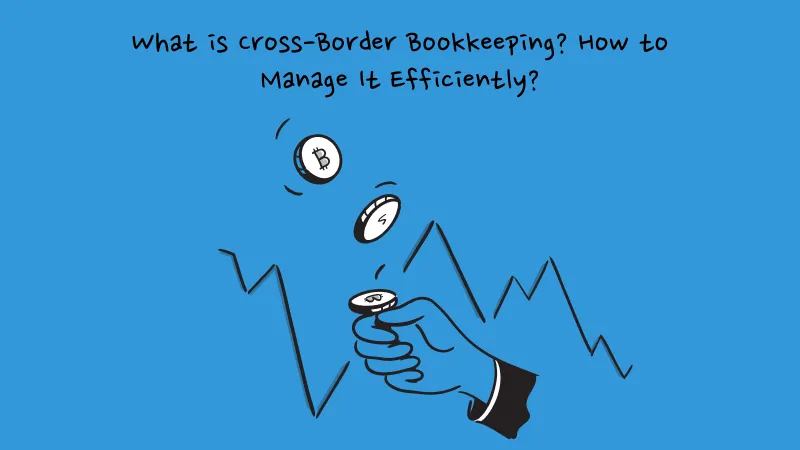What is Cross-Border Bookkeeping? How to Manage It Efficiently?

If your startup works with global clients, or expands into new markets, you’ll have to deal with multiple tax laws, regulatory filings, and reporting timelines that don’t sync up. Simply converting dollars to rupees or euros to yen don’t cut it. You need a proper mechanism to perform cross-border bookkeeping.
It ensures every financial transaction, no matter where it happens, is recorded accurately, categorized properly, and filed in a way that meets local rules.
But without the right systems, things can slip fast. One small misstep could lead to penalties, delays, or an audit surprise.
This guide walks you through what cross-border bookkeeping involves, where businesses go wrong, and how to set up a system that scales with your global footprint.
What is Cross-Border Bookkeeping? Why Does It Matter?
The primary objective of bookkeeping is to ensure that your finance numbers hold up under scrutiny. Cross-border bookkeeping does that across jurisdictions.
It ensures your financial transactions are compliant not just in your home country, but wherever you operate. Whether you’re paying contractors in Europe, receiving payments from the US, or running payroll in India, your books need to reflect each of those correctly with documentation that fits local rules.
Cross-border bookkeeping gives you financial clarity, improves tax readiness, and reduces legal risk. Done wrong, it can lead to missed filings, inconsistent reporting, and steep penalties.
Here’s what makes cross-border bookkeeping from domestic bookkeeping:-
- For cross-border bookkeeping, you need to manage currency conversions and handle fluctuating exchange rates for every transaction across borders.
- Regional tax systems vary. Some may require VAT or GST documentation, while others don’t. You need to capture all these different regulations.
- Reporting cycles differ by country, making consolidated month-end closes more complex.
- Language and data format differences can slow down reconciliation, especially when dealing with localized systems or invoices.
What Challenges do Businesses Face with Cross-Border Bookkeeping?
When you’re operating in different geolocations, you’re working with multiple currencies, compliance, and different data formats. It’s easy to miss a regulation that didn’t apply in your home country.
These challenges multiply as you scale. What felt manageable with one international client or contractor becomes overwhelming across multiple entities or markets.
Here are common issues to watch for in different jurisdictions:-
- Currency conversion errors, especially when rates change between invoicing and settlement can distort your books.
- Managing VAT, GST, or other layered tax systems across regions creates complexity in classification and reporting.
- Countries follow different reporting standards, which can make consolidated financials hard to produce and audit-ready.
- Local compliance requirements, such as KYC and AML regulations, differ significantly between jurisdictions.
- Language and formatting inconsistencies across invoices and statements slow down reconciliation.
- Missing a tax or audit deadline in one country can result in fines, interest charges, or reputational risk.
Imagine you're running a startup incorporated in the US with a growing team in India. Your US entity follows a calendar year for tax reporting, while India’s fiscal year ends in March. Coordinating closing timelines, managing documentation formats, and aligning tax treatments across both countries takes careful planning, and if one piece is delayed, your compliance in both jurisdictions can suffer.
How Can Businesses Simplify Cross-Border Bookkeeping?
Managing compliance across borders doesn’t have to mean more spreadsheets or late nights. With the right setup, you can automate the busywork, reduce errors, and keep your books audit-ready, even as operations expand.
Start by streamlining the parts that consume the most time: transaction entries, reconciliations, and tax formatting. Then, layer in tools and partners that are built for global finance from the start.
Manual bookkeeping falls apart quickly in cross-border settings. Currency mismatches, multiple bank accounts, and time zone delays lead to gaps and duplication. Automation tools help match payments to invoices, apply real-time exchange rates, and update ledgers instantly, so your team isn’t scrambling at month-end.
Look for features that go beyond basic accounting:
- Multi-currency accounts payable (AP) automation, so you can pay vendors without constant conversions.
- Real-time dashboards that reflect exchange rate movements and their effect on your cash position.
- Cloud-based reporting platforms that consolidate data across regions and entities.
- Tools that auto-generate audit-ready documentation formatted to local standards.
Sometimes, the best move is not doing it yourself. Cross-border bookkeeping partners bring local expertise, handle tax nuances, and help you stay compliant across jurisdictions without hiring a full in-house team. For startups, this means fewer errors, lower risk, and more time to focus on growth.
What Should You Prioritize for Global Compliance?
Staying compliant across borders is more than ticking off filings. It’s about knowing what each country expects, and building systems that meet those expectations automatically. If you're managing entities, vendors, or customers in different jurisdictions, these should be non-negotiables in your finance stack.
Stay Current with Tax and Reporting Laws
Tax and reporting rules change often, and they rarely align across regions. Keep these priorities top of mind:
- Stay on top of local tax filings and understand which regions require VAT, GST, or other indirect taxes.
- Track reporting deadlines for each country. Some follow the calendar year, others don’t.
- Understand and document country-specific audit requirements, such as what qualifies as acceptable proof of expense or revenue.
Build Compliance into Your Systems
Don’t wait until audit season to organize your documentation. Use tools that make compliance the default process.
Invest in software that’s KYC- and AML-ready, supports secure documentation storage, and keeps a traceable record of transactions. When regulations change, your systems should be flexible enough to adapt without needing a manual overhaul.
Why Does Outsourcing Cross-Border Accounting Make Sense?
Hiring an internal team that understands multiple tax systems, currencies, and reporting formats is expensive, and often not realistic for early-stage companies. Outsourcing gives you access to global expertise without the overhead. It also reduces errors, shortens close cycles, and helps you stay compliant while scaling into new markets.
Here are some bnefits of working with global finance partners
- Gain faster turnaround on tax filings, audits, and compliance checklists, especially in complex jurisdictions.
- Tap into regional expertise from professionals who know the nuances of local regulations and workflows.
- Reduce the cost of hiring and training full-time finance staff for every country you operate in.
- Access support that scales with your business, whether you’re expanding into one new country or five.
The right time to outsource is usually earlier than most startups think. If you’re entering a new market, dealing with unfamiliar tax obligations, or facing delays with local filings, that’s your cue. Outsourced teams can help set things up right the first time before problems compound.
Tools for Cross-Border Bookkeeping
Technology can take the pain out of multi-country bookkeeping but only if you choose tools built for the complexity of global operations. Combine that with good habits like monthly reviews and proactive compliance checks, and your cross-border finance stack starts running itself.
Look for these features while looking for cross-border bookkeeping software:-
- Support for multiple currencies with real-time exchange rates to ensure transactions reflect true value.
- Automated tax validation and reporting tools tailored to regional requirements like GST, VAT, or 1099s.
- Centralized dashboards that let you monitor activity by entity, region, or currency - all in one place.
- Encrypted document storage and audit logs to keep your compliance records secure and easy to retrieve.
Even with automation, human review remains essential. Make it part of your monthly routine to go through the books and confirm that nothing has slipped through the cracks across countries or teams. Keep exchange rate data current, especially if you’re dealing with volatile markets or high-value transactions. Finally, stay alert to local compliance updates, whether it’s a revised tax form, new audit requirements, or shifting KYC thresholds.
How Inkle Helps Simplify Cross-Border Bookkeeping
If you're managing operations across multiple countries, you already know how complicated cross-border bookkeeping can get. Inkle is built specifically for such startups.
Inkle automates cross-border bookkeeping with tools designed to meet the regulatory, currency, and reporting needs of US-India entities. It removes manual effort and helps you stay audit-ready without scrambling at deadlines.
Here are features specifically built to streamline global finance:-
- Automatically categorizes transactions and reconciles accounts across currencies and banks.
- Tracks GST/VAT in India and US compliance obligations like 1099s or state filings - all in one system.
- Delivers real-time cash flow insights across currencies, so you’re never caught off guard.
- Sends timely alerts for filing deadlines, helping you stay compliant without constant calendar checks.
Inkle goes beyond automation, with human-in-the-loop review and access to finance experts who can flag edge cases, update you on regulation changes, or offer help when things don’t fit the template. Book a demo and see Inkle in action.
Frequently Asked Questions
What’s the difference between cross-border and international bookkeeping?
The terms are often used interchangeably, but cross-border bookkeeping usually refers to managing financial operations across legal jurisdictions where compliance, tax rules, and reporting requirements vary country by country. International bookkeeping, on the other hand, is a broader term that covers financial recordkeeping for businesses operating across more than one nation.
How do I manage currency conversions accurately in bookkeeping?
Use accounting software that pulls real-time exchange rates and logs the source and time of each conversion. This ensures transparency and audit-readiness, especially if exchange rates fluctuate during the billing cycle.
Do I need different books for each country I operate in?
Yes. Maintaining separate ledgers or sub-books by country helps ensure compliance with local tax laws, reporting periods, and audit standards. Consolidation can happen at the entity or group level.
What if I miss a filing in one country?
Penalties depend on the region ranging from late fees and interest to regulatory warnings. The best way to avoid this is to use tools with built-in reminders and to work with advisors who understand local deadlines.
How do I choose the right cross-border accounting software?
Look for tools with multi-currency support, tax-ready documentation, and integrations with your payment systems. Bonus points if it handles both US and international compliance in one place.
Can I handle cross-border bookkeeping in-house?
You can, especially if you’re early-stage and have simple operations. But as you grow, outsourcing to experts who understand cross-jurisdictional compliance often saves time, reduces risk, and improves accuracy.




